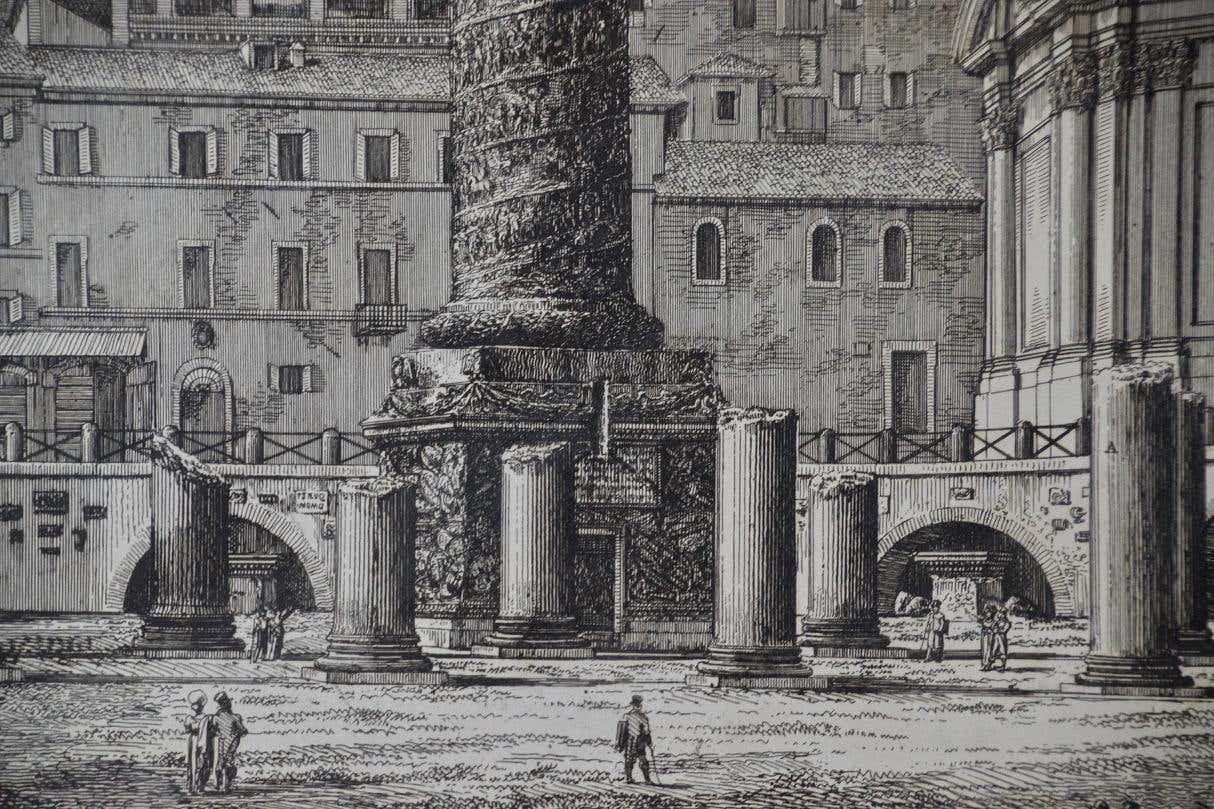19th Century Etching of the Ancient Caracalla Baths in Rome by Luigi Rossini
This early 19th century etching entitled "Veduta dei Grandi Avanzi delle Terme Antoniane, o di Caracalla" (The baths of Caracalla) was created by Luigi Rossini and included in his publication "Le Antichita Romane" (The Rome of Antiquity), published in Rome in 1823. It depicts the ruins of the historical Caracalla Baths as they appeared in the early 19th century. People are seen in the foreground giving perspective to the immense size of the ruins. One person in the open area between buildings appears to be shooting a rifle, perhaps target practice. The Baths of Caracalla were built in the early 3rd century by Emperors Septimius Severus and Caracalla (the son of Septimius Severus) and were in use until the 6th century. They were considered one of the wonders of ancient Rome. Much of the original building was destroyed in the earthquake of 847. Famous sculptures that once adorned the baths (over 120) include the Farnese Bull (the largest surviving sculpture from antiquity) and the Farnese Hercules.
Creator: Luigi Rossini (1790-1857, Italian)
Creation Year: 1823
Dimensions: Height: 27 in (68.58 cm)
Width: 29 in (73.66 cm)
Depth: 1 in (2.54 cm)
Medium: Etching
Condition: See description below.
This early 19th century etching entitled "Veduta dei Grandi Avanzi delle Terme Antoniane, o di Caracalla" (The baths of Caracalla) was created by Luigi Rossini and included in his publication "Le Antichita Romane" (The Rome of Antiquity), published in Rome in 1823. It depicts the ruins of the historical Caracalla Baths as they appeared in the early 19th century. People are seen in the foreground giving perspective to the immense size of the ruins. One person in the open area between buildings appears to be shooting a rifle, perhaps target practice. The Baths of Caracalla were built in the early 3rd century by Emperors Septimius Severus and Caracalla (the son of Septimius Severus) and were in use until the 6th century. They were considered one of the wonders of ancient Rome. Much of the original building was destroyed in the earthquake of 847. Famous sculptures that once adorned the baths (over 120) include the Farnese Bull (the largest surviving sculpture from antiquity) and the Farnese Hercules.
Creator: Luigi Rossini (1790-1857, Italian)
Creation Year: 1823
Dimensions: Height: 27 in (68.58 cm)
Width: 29 in (73.66 cm)
Depth: 1 in (2.54 cm)
Medium: Etching
Condition: See description below.
This early 19th century etching entitled "Veduta dei Grandi Avanzi delle Terme Antoniane, o di Caracalla" (The baths of Caracalla) was created by Luigi Rossini and included in his publication "Le Antichita Romane" (The Rome of Antiquity), published in Rome in 1823. It depicts the ruins of the historical Caracalla Baths as they appeared in the early 19th century. People are seen in the foreground giving perspective to the immense size of the ruins. One person in the open area between buildings appears to be shooting a rifle, perhaps target practice. The Baths of Caracalla were built in the early 3rd century by Emperors Septimius Severus and Caracalla (the son of Septimius Severus) and were in use until the 6th century. They were considered one of the wonders of ancient Rome. Much of the original building was destroyed in the earthquake of 847. Famous sculptures that once adorned the baths (over 120) include the Farnese Bull (the largest surviving sculpture from antiquity) and the Farnese Hercules.
Creator: Luigi Rossini (1790-1857, Italian)
Creation Year: 1823
Dimensions: Height: 27 in (68.58 cm)
Width: 29 in (73.66 cm)
Depth: 1 in (2.54 cm)
Medium: Etching
Condition: See description below.
The etching is presented in a black wood frame with a light brown outer mat and a dark brown inner mat. There are small spots in the right upper and mid portion of the print and three vertical light bands in the upper portion of the print. It is otherwise in very good condition.
Luigi Rossini (1790-1857) like his predecessors, Giovanni Piranesi (1720–1778) and Giuseppi Vasi (1710-1782), was an architect and artist. Like Piranesi and Vasi, he wanted to glorify the architecture of ancient Rome, which he felt was deteriorating and needed to be documented. Several of the ruins he illustrated have, in fact, since disappeared leaving only his images as a record of their appearance. His images of the grand edifices of the city dramatically depict the power and glory of ancient Rome reflected by its architecture, but were accurate enough to be used by practicing architects, as well as other serious students of classical antiquity. His art continues to influence and inspire architects, artists and those who love Rome.
Rossini was born in Rome and trained at the Academy of Bologna. Upon graduation, he moved to Rome and attempted a career as an architect. As he was not economically successful as an architect, he became a full-time artist, initially producing souvenirs for local collectors, wealthy and aristocratic European tourists on the Grand Tour, as well as for architectural students and practitioners all over Europe. Many of his prints were published in several imperial folio sized collections, including Le Anchita Romane (The Rome of Antiquity).































